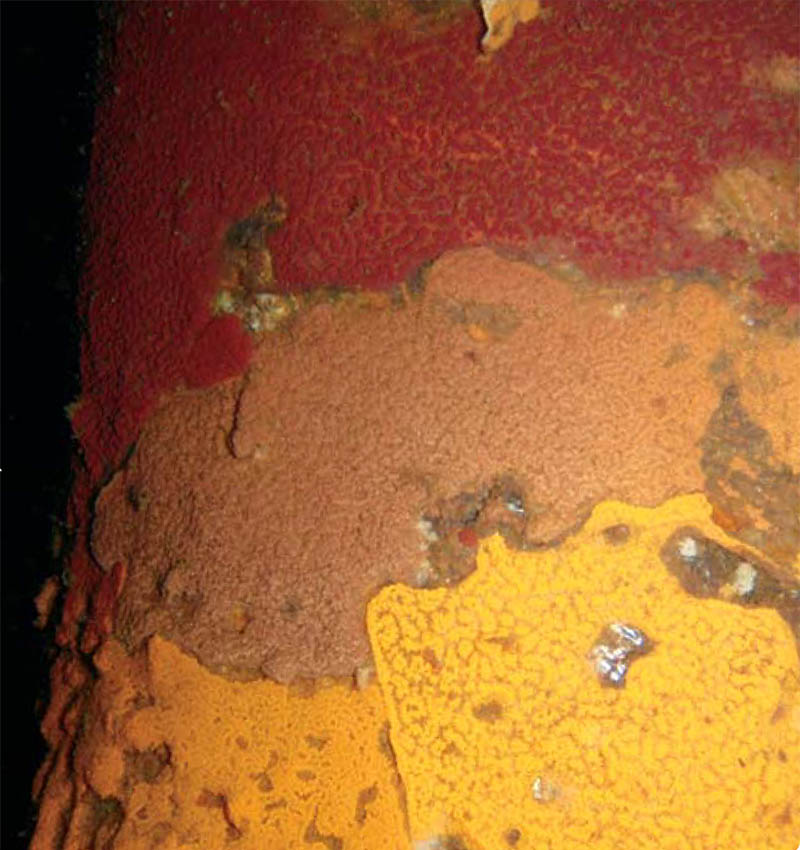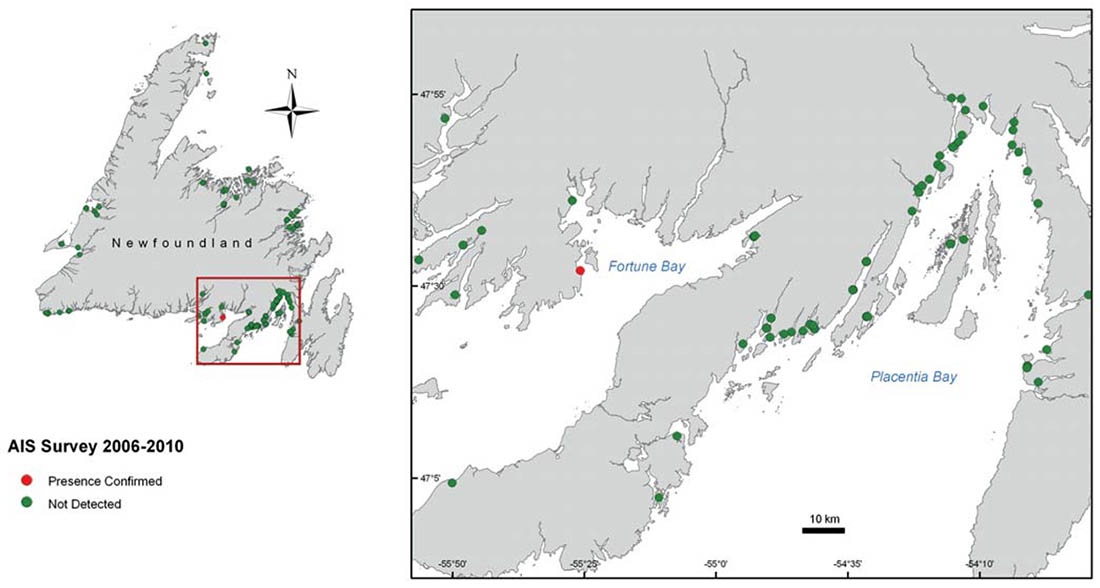Violet Tunicate in Newfoundland and Labrador Waters
Tunicates are aquatic animals with a sac-like body protected by a coat or 'tunic'. They may live in colonies and feed by filtering sea water through their bodies. Researchers think that tunicates first appeared over 500 million years ago.
The violet tunicate (Botrylloides violaceus) is native to the northwestern Pacific Ocean and was discovered in North America around 1945. It was first identified in Belleoram, Newfoundland and Labrador in 2007. As of 2010, it has not spread beyond the waters of Belleoram (see map).
Adult violet tunicates grow in colonies approximately 10 cm in diameter. The colonies are often densely packed together and can grow as mats or 'lobes' over surrounding terrain that are up to 5 cm long. Violet tunicate can be distinguished from other tunicate colonies by the apparently random arrangement of individuals. They have distinct ridge or track-like patterns on the surface of their fleshy coat. Violet tunicate has fewer colour patterns than the golden star tunicate and is typically evenly coloured in shades of orange, burgundy, dull pink, lavender or purple.
The lifecycle of violet tunicate is not fully understood but we know that they can reproduce in two ways: when fragments of a colony break off and bud elsewhere, and by the production of eggs which hatch into free-swimming larvae. Colony fragments may travel over great distances and the fragments are able to reproduce for up to 40 days. Larvae released into the water column settle within 48 hours, and only travel small distances.
Environmental Impact of Violet Tunicate
Violet tunicate is a filter feeder, getting nutrients from phytoplankton (algae), bacteria and other small organic things that float in the sea. In large numbers, the tunicate competes for food with other filter feeders, such as mussels and scallops.
Violet tunicate is mostly composed of water. lt grows rapidly compared to other marine organisms. lt may cover surrounding plants and animals and deprive them of sunlight or food. Violet tunicate may even suffocate smaller organisms, such as juvenile mollusks. lt releases a chemical that can make it hard for other organisms to attach properly to surfaces. These organisms then become vulnerable to being removed by water currents. This chemical can also repel and inhibit growth in predators. All of this makes the violet tunicate harmful to shellfish harvesters, aquaculture farmers, and aquatic organisms that live on the bottom of the ocean.
Discovery and Survey Findings
During a survey in September 2007, violet tunicate was discovered in Belleoram, Fortune Bay. This is a concem to the aquaculture industry in Newfoundland. However, this species has not yet been found in local mussel farms. Fortunately its distribution appears to be restricted to Belleoram where it is being found on wharf structures, ship hulls, plastic surfaces, rocks, and wild mussels.
This species still poses a potential risk to bottom dwelling aquatic animals in other parts of Newfoundland and Labrador so it is important to continue to monitor other areas. This will help in the long-term management and prevention of the spread of violet tunicate.
Methods to Control the Spread of Violet Tunicate
Tunicates can spread through the movement of fishing gear, shellfish, and recreational and commercial vessels. To control the spread of violet tunicate, boat hulls and fishing gear should be visually inspected and cleaned when necessary.
To prevent the spread of living fragments, water inside boats should be drained and the boat should be allowed to dry for 24 hours. Also, because violet tunicate can rapidly colonize and establish large, self-sustaining populations, it should be removed from wharves and surrounding structures.
In 2008-2009, Fisheries and Oceans Canada worked with Memorial University of Newfoundland to test various mitigation methods in Belleoram. This included wrapping wharf pilings and covering affected rocks and structures with plastic. While this killed many violet tunicate, they eventually came back and resettled in large numbers on and around the treated surfaces.
As of 2010, other methods of prevention and control are being tested, including the introduction by Fisheries and Oceans Canada of sea urchins to the Belleoram wharf. Sea urchin eat violat tunicate and the department is studying whether the sea urchins will control the population through predation.
Continuing survey and monitoring work will improve our understanding of the violet tunicate. Understanding an organism's lifecycle in its newly invaded environment helps us to establish where and when to target prevention and control efforts. It is especially important that we understand how violet tunicate over-winter and when they sexually reproduce. When combined with surveys (see map), using genetic tools to find eggs and larvae of violet tunicate will us help target our efforts.
References
- Berrill NJ (1950) The Tunicata, wilh an account of the British species. Ray Society, London. Publication 133: iii + 354 pp
- Callahan AG, Deibel D, McKenzie CH, Hall JR & Rise ML (2010) Survey of harbours in Newfoundland for indigenous and non-indigenous ascidians and an analysis of their cytochrome c oxidase I gene sequences. Aquat Inv 5: Doi 10.339/ai2010.5.1
- Carver CE, Mallet AL & Vercaerner B (2006) Biological synopsis of the colonial tunicates, Botryllus schlosseri and Botrylloides violaceus. Can Mans Rep Fish Aquatic Sei, 2747, DFO. 42 pp
- Lambert CC & Lambert G (2003) Persistence and differential distribution of nonindigenous ascidians in harbors of the Southern California Bight. Mar Eco! Prog Ser, 259:145-161
- Oka A (1927) Zur kenntnis der japanischen Botryllidae (vorlaufige Mitteilung). Proc Irnp Acad, 3: 607-609
- Van Name WG (1945) The North and South American ascidians. Bull Am Nat Hist, 84 pp
© Her Majesty the Queen in Right of Canada, 2011
DFO/2011-1721
Cat. No.: Fs23-555/3-2011E-PDF
ISBN: 978-1-100-18103-5
- Date modified:


